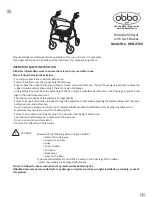
Adapt
34
Figure 30:
Attachment angle
Figure 31: Positioning of belts
The lap belt must sit where the hip meets the pelvis on the front of the body. The belt must sit
close to the body. The upper belt must support the user fully (see Figure 31).
The diagonal belt must run over the shoulder and chest.
The belts have to be tight, but not so tight that they are uncomfortable for the user.
The belt must not be put on twisted.
The belt must not be in contact with parts of the mobility base for seating shells (such as forearm
supports or wheels) in such a way that the belt no longer fully supports the user's body (see
Figure 32).
The approved 3-point safety belt is designed to prevent injury to the head and chest.
The aforementioned information regarding safety belts is based on the ISO 7176-19
crash test, to which the Adapt has been subjected.
To avoid injury to other passengers, the tray (if present) must be removed. This tray
must be stored securely in the vehicle.
Accessories must be secured or removed as far as possible.
After each accident, the manufacturer's representative must assess whether the mobil-
ity base for seating shells can be used again.
The attachment points or the structural and frame parts must not be changed and/or
replaced without consulting the manufacturer.
Summary of Contents for Adapt
Page 1: ...Adapt Instructions for use...
Page 41: ...Adapt 41...
Page 42: ...Adapt 42...
Page 43: ...Adapt 43...











































